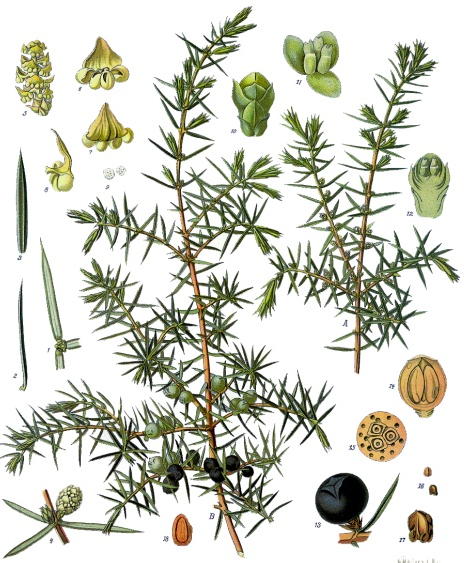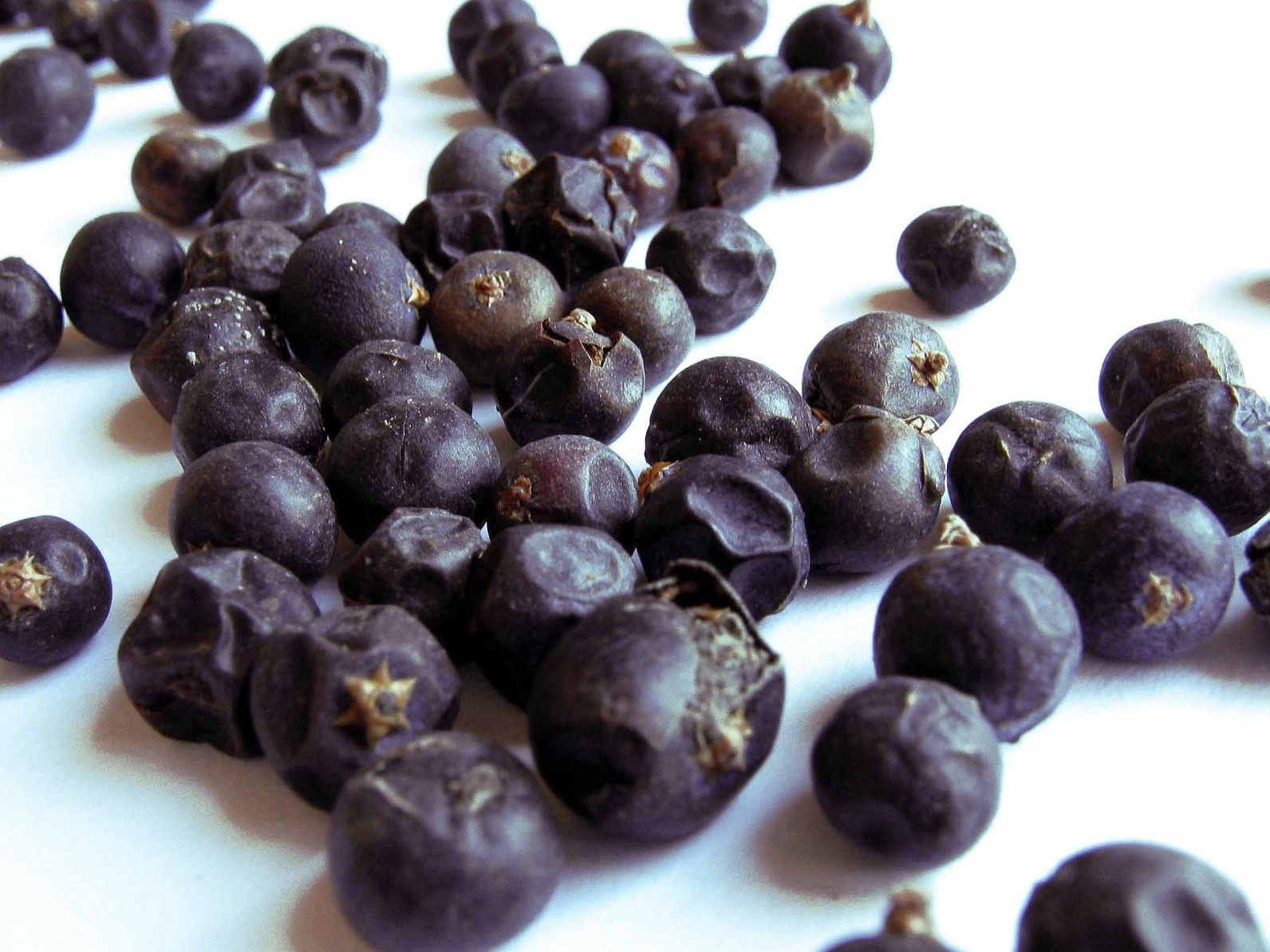
Juniperis communis (L)
Synonyms and Common names: Genevrier, Ginepro, Enebro, Baccae Juniperi
German = Wacholder, French = Genievre, Spanish = Junipero, Italian = Ginepro, Chinese = Kuli
 Order: Cupressaceae
Order: Cupressaceae
Description: Juniper is an evergreen coniferous shrub or small tree occurring
throughout the northern hemisphere from Europe to Siberia and grows up to 10m in
height; it can be either prostrate or erect. Its preferred habitat is heath,
moorland and chalk downs, but is also
found as undergrowth in mixed open forests. It is particularly common in
pastures where sheep graze as they eat the berries and distribute the seeds in
their faeces. As its botanical name suggests, Juniperis communis often occurs in groups.
The bark is
chocolate-brown tinged with red. The leaves, 5-20mm long, are needle-like and stalkless,
occurring in whorls of three, and are pale green below and dark shiny green on the
other three sides. The male plant bears a cone 1cm long, the female a much
smaller one; the fruit, about 1cm in diameter, appears on the female
plant. Initially green, it turns purplish-black with a greyish bloom in
the second and third year and has a triangular indentation at the apex.
Flowering takes place in April and May and the fruits ripen in September and October of
the following year.
Parts used: berries
Collection: The berries are harvested in the autumn of their second year when they are bluish-black in colour. They should be dried carefully to preserve the volatile oil. The fresh berries can be made into a syrup.
Constituents: up to 2% volatile oil (including pinene, myrcene, terpinene, thujone, sabinene, limonene and camphine), up to 10% resin, up to 33% sugar, flavone glycosides, condensed gallotannins, bitter substance (juniperin), anti-tumour agent (podophyllotoxin), organic acids, vitamin C, tannins.
Actions: Diuretic, increasing the elimination of acid metabolites; urinary antiseptic, carminative, stomachic, antirheumatic, uterine stimulant, anti-inflammatory
Indications: specifically indicated in cystitis, in the absence of renal inflammation.
Therapeutics and Pharmacology: Juniperus is primarily used in the treatment of urinary tract infections such as cystitis and urethritis. The antiseptic volatile oil is excreted in the urine, disinfecting the urinary tract as it passes through. This action is enhanced by a diuretic effect which dilutes the urine. The volatile oil component, terpinen-4-ol, is reported to increase the glomerular filtration rate of the kidneys. Juniperus is also applicable to urinary calculi.
It is a useful remedy for gastric conditions resulting from an underproduction of hydrochloric acid and is also of benefit in gastrointestinal infections, inflammations and cramps. The bitter action aids digestion and relieves flatulent colic.
Juniperus is often used in the treatment of rheumatism, arthritis and gout, and other arthritic conditions associated with the accumulation of acid waste. Here, it promotes the excretion of uric acid at the kidney. Applied externally, the diluted essential oil penetrates the skin to help relieve joint and muscle pain and neuralgia. It warms the tissues by perfusing them with blood. The undiluted oil is irritant and is likely to cause inflammation and blisters.
As a vapour bath, Juniperus is helpful in the treatment of bronchitis and lung infections. when chewed, the berries freshen the breath and help heal infected gums. Anti-viral activities exhibited by the volatile oil have been partially attributed to the flavonoid amentoflavone.
Juniperus stimulates uterine muscle and so can be used in delayed menstruation, but it must never be used during pregnancy.
Combinations: Juniperus combines well with Alchemilla arvensis in cystitis while Juniper and Thyme essential oils in a carrier oil may be used as a chest rub for stubborn coughs.
 Caution: The volatile oil is stimulating to the kidney nephrons, so
Juniperus should never be used in patients with renal disease (a warning sign is
albuminuria). A uterine stimulant, it is contraindicated in pregnancy, and
should never be used in the treatment of children. Juniperus is irritant to many
tissues and the turpentine-like oil can cause cramps when inhaled. It should
not be taken internally for more than six weeks
and the internal use of the oil must always be supervised by a qualified
practitioner.
Caution: The volatile oil is stimulating to the kidney nephrons, so
Juniperus should never be used in patients with renal disease (a warning sign is
albuminuria). A uterine stimulant, it is contraindicated in pregnancy, and
should never be used in the treatment of children. Juniperus is irritant to many
tissues and the turpentine-like oil can cause cramps when inhaled. It should
not be taken internally for more than six weeks
and the internal use of the oil must always be supervised by a qualified
practitioner.
Preparation and Dosage: (thrice daily)
Regulatory Status: GSL
Infusion: 1:20 in boiling water, 100ml
Liquid Extract: 1:1 in 25% alcohol, 2-4ml
Tincture: 1:5 in 45% alcohol, 1-2ml
Additional Comments: It is said that ‘he who cuts down a juniper will die within the year’. Juniper was burned in the Middle Ages to ward off Plague. Juniper branches were a popular strewing herb. As a spice, the berries are used to flavour gin, Chartreuse and game dishes, and the Swedes use them in a beer. They impart the smell of violets to the urine.
Juniper tar, or oil of cade, is produced by the distillation of the wood of another species, J.oxycedrus (Prickly juniper), which contains phenol and has a mild disinfectant action. Applied externally, it is non-irritant and is mainly used to treat chronic skin conditions such as scaling eczema and psoriasis, or for hair loss.
Bibliography
Bartram, T. 1995 Encyclopedia of Herbal Medicine, 1st edn., Grace Publishers, Bournemouth.
Bremness, L. 1994 Herbs, Dorling Kindersley Eyewitness Handbook, London.
BHMA 1983 British Herbal Pharmacopoeia, BHMA, Bournemouth.
Chevallier, A. 1996 The Encyclopaedia of Medicinal Plants, Dorling Kindersley, London.
Grieve, M. 1931 A Modern Herbal, (ed. C.F. Leyel 1985), London.
Hoffmann, D. 1990 The New Holistic Herbal, Second Edition, Element, Shaftesbury.
Lust, J. 1990 The Herb Book, Bantam, London.
Mabey, R. (ed.) 1991 The Complete New Herbal, Penguin, London.
Mills, S.Y. 1993 The A-Z of Modern Herbalism, Diamond Books, London.
Newall, C.A., Anderson, L.A., & Phillipson, J.D. 1996 Herbal Medicines: A Guide for Health-care Professionals, The Pharmaceutical Press, London.
Ody, P. 1993 The Herb Society's Complete Medicinal Herbal, Dorling Kindersley, London.
Polunin, M. and Robbins, C. 1992 The Natural Pharmacy, Dorling Kindersley, London.
Prihoda, A. 1989 The Healing Powers of Nature, Octopus, London.
Richardson, R. 1988 The Little Spice Book, Piatkus, Loughton.
Vickery, R. 1995 A Dictionary of Plant Lore, Oxford University Press.
Weiss, R.F. 1991 Herbal Medicine, Beaconsfield Arcanum, Beaconsfield.
Wren, R.C. 1988 Potter's New Cyclopaedia of Botanical Drugs and Preparations, C.W.Daniel, Saffron Walden.










